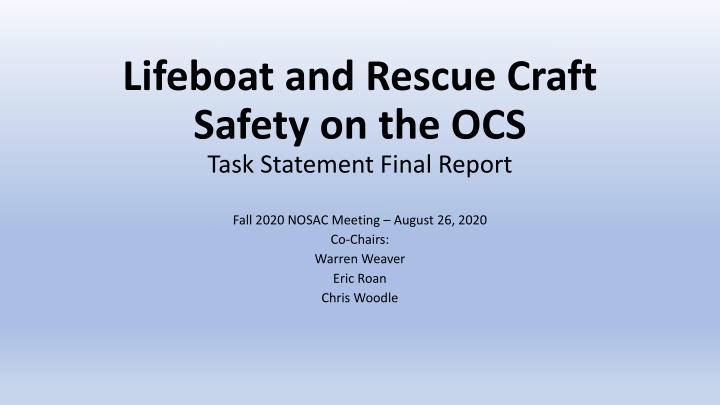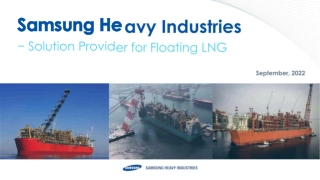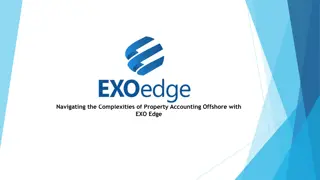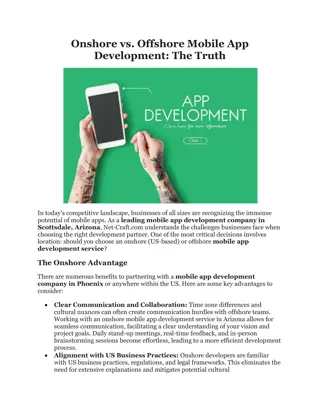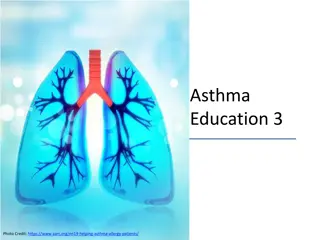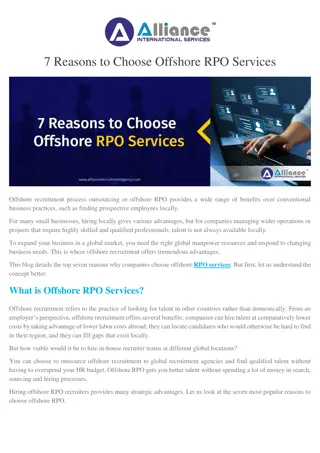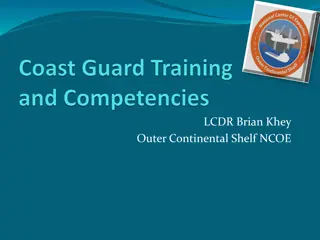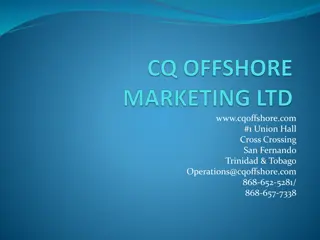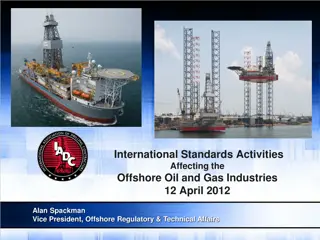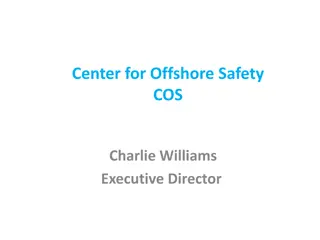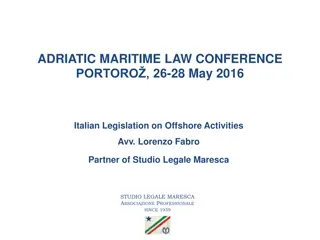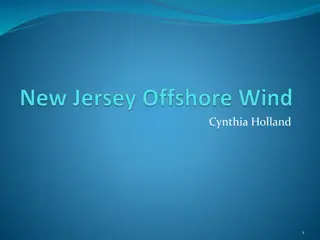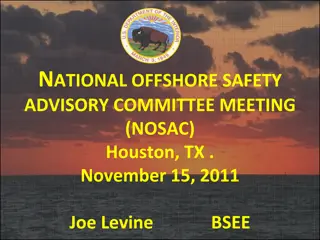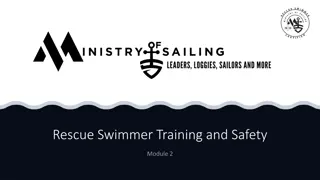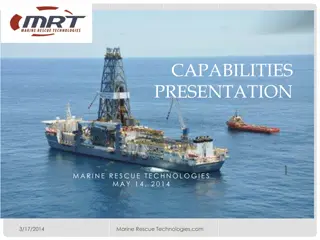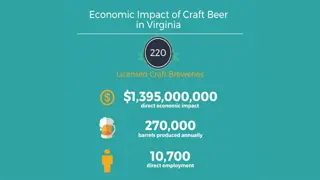Safety Focus on Lifeboat & Rescue Craft Operations in Offshore Operations
This report highlights the crucial aspects related to lifeboat and rescue craft safety on offshore facilities, focusing on regulations, training, equipment readiness, and past incidents. Key topics include the regulatory framework, differences between fixed and floating facilities, USCG oversight, training requirements, and challenges in launching and recovery operations.
Download Presentation

Please find below an Image/Link to download the presentation.
The content on the website is provided AS IS for your information and personal use only. It may not be sold, licensed, or shared on other websites without obtaining consent from the author.If you encounter any issues during the download, it is possible that the publisher has removed the file from their server.
You are allowed to download the files provided on this website for personal or commercial use, subject to the condition that they are used lawfully. All files are the property of their respective owners.
The content on the website is provided AS IS for your information and personal use only. It may not be sold, licensed, or shared on other websites without obtaining consent from the author.
E N D
Presentation Transcript
Lifeboat and Rescue Craft Safety on the OCS Task Statement Final Report Fall 2020 NOSAC Meeting August 26, 2020 Co-Chairs: Warren Weaver Eric Roan Chris Woodle
Meetings Held September 11, 2019: Task Statement issued by USCG October 2, 2019: Teleconference Kickoff meeting (23 attendees) October 16, 2019: In-person meeting at IADC s offices in Houston, TX (38 attendees) December 12, 2019: In-person meeting at Exxon s offices in Spring, TX (41 attendees) February 27, 2020: In-person meeting at Oxy s offices in The Woodlands, TX (28 attendees) May 28, 2020: Teleconference (28 attendees) July 23, 2020: Teleconference (28 attendees)
Special Recognitions Offshore Operators Committee (OOC) IADC for hosting the 1stin-person meeting Exxon for hosting the 2ndin-person meeting Oxy for hosting the 3rdin-person meeting Palfinger, Alexander-Ryan, Fassmer, Norsafe (Viking), Survival Systems International (SSI), and Survitec (especially for demos at 2ndmeeting) Virtual Marine Technology (VMT), and All Subcommittee members!!
Related Activities OOC Lifeboat Workgroup and the development of a Guidance Document that provides a minimum framework to achieve in lieu of periodic launches to water in order to prove equipment readiness and operator competency (based on IMO MSC Circular 1486) Fact-finding trip to St. John s, Newfoundland (March 2-4). Met with Regulators, Researchers, and Operators to learn how they collaboratively addressed ways to mitigate risks around lifeboat launching to prove equipment operational readiness and operator competency. Trip organized and hosted by VMT Shell Lifeboat Incident Investigation share (March 9).
Main Report Task Statement Description and Overview Scope of report Primarily focused on fixed and floating OCS facilities (i.e. production platforms) Because other units benefit from more relevant, contemporary regulations (IMO), and related policy (e.g. IMO MSC Circ. 1486) General background highlighting regular occurrences of incidents Relevant factors related to the issue: Regulatory framework Differences in requirements between fixed and floating OCS facilities Requirements for periodic launching (not explicit) Oversight, training, and experience of USCG inspectors Equipment selection by operators Training and experience of offshore personnel with lifesaving duties Training providers and approval and oversight of courses offered Marine casualty history (not complete or reliable) Risks and challenges associated with launching (and recovery) from platforms (highlights OOC Guidance Document and relevant recommendations from the GLOMAR JAVA SEA Marine Board of Investigation)
Main Report Task Statement Description and Overview (cont.) These issues need action Is how we are doing it part of the problem? Confidence is not high anything will be addressed via a regulatory effort. Can CG address in other ways were law/regulation supports policy? Where it does not, can some other form of guidance be offered (CG or external?) Status quo is not acceptable.
Task Number 1 Review the 2015 NOSAC Final Report and update any recommendations that have become dated or that need to be modified. It is clear from the way the 2015 TS was written that the CG recognized the added risks of launching in open water. 2015 effort did not fully capitalize on the opportunity to identify the significant differences in launching/recovering lifeboats in protected water vice open water. Did not recognize the unique challenges that offshore platforms have with doing this (height above water, non-shipshape structure, inability to stabilize craft, etc.) Offered revised recommendations for all 10 of the recommendations made in the 2015 Report.
Task Number 2 Research and identify potential modifications that could be added to already required lifeboat equipment (SOLAS equipment) and lifeboat arrangements that would be more appropriate for lifesaving appliances installed on an OCS unit. Issue would benefit from an Escape, Evacuation, and Rescue (EER) analysis. Discussion of differences in required equipment between fixed and floating platforms. Discussion of the need to establish a GOM Standard of lifeboat equipment as minimum required standard now may be excessive or not useful. 1 Recommendation to create a GOM Standard for required lifeboat equipment.
Task Number 3 Identify potential design flaws for lifeboats, rescue craft, and their launching and recovery arrangements that, if addressed, would enhance the safety of the lifeboat and or rescue craft including launching and recovery from an OCS unit including; a. Analyzing Mobile Offshore Drilling Unit (MODU) requirements from 46 CFR Subchapter I-A for suitability to floating OCS units. b. People on Board (POB) standard (weight/body size) etc. (Federal Register Docket ID: USCG-2012-0848) Lifeboat design is based around minimum regulatory standards. Not much incentive to change unless driven by regulation. Previous casualty report (Glomar Java and Ocean Ranger) highlighted design issues that could be improved. Other designs/systems should be explored.
Task Number 3 (cont.) IMO addressed risks with launching offshore via MSC.1/Circ.1486 The weight issue people and equipment. 5 recommendations for lifeboat design. 4 recommendations to address the weight issue. 5 recommendations for lifeboat arrangements (and protection).
Task Number 4 Recommend suggested changes to existing regulations and/or policies governing lifeboats and/or rescue craft to address the unique operational issues found on OCS units. Since new regulation is not likely (or timely if it was), we need to do what we can to address via other guidance or policy. Highlights relevant regulations made in the 2018 Regulatory Reform Report for the Production Sector. 14 recommendations from 2018 highlighted with revised recommendations relevant to this TS provided where appropriate. 5 additional ( new ) recommendations made for this TS
Task Number 5 Recommend suggested changes or alternatives for competency assurance/training for crew serving on OCS units and lifesaving equipment testing. Launching to water is not the only way to achieve the objectives around proving equipment operations and demonstrating operator competency. We need to look outside the US for other examples and policy that supports alternative methods. The conundrum: We are required to ensure the equipment is in good condition (operational readiness at all times). (33 CFR 146.15) We are obligated to provide lifeboat operators who are competent in the use of the equipment and to be able to demonstrate their competency. (33 CFR 146.125(a)) Traditional methods of proving operational readiness and operator competency have been verified during periodic launches in open water, however this activity poses significant recognized risk. Offshore platforms have unique challenges and risks with the launching and recovery of lifeboats (especially during recovery).
Task Number 5 (cont.) Personnel should not be allowed in the boats during lowering and recovery. This is a practice increasingly disallowed in merchant shipping and other offshore areas and simply recognizes that most lifeboat casualties occur during these two phases of the operation. The transferring of personnel to an already lowered lifeboat, while doable, also adds additional risks to an activity already replete with risk. There are other recognized best practices that exist in other offshore areas and have proven effective related to lifeboat testing that do not require launching at all. For the industry this involves identifying and managing risk in accordance with our values - we have zero tolerance for not managing potentially fatal outcomes to as close to zero as we can because it s simply the right thing to do. As the agency charged with ensuring and progressing marine safety on the U.S. OCS, the USCG should also recognize these risks and be willing to collaborate constructively with the industry to advance safer, more practical alternatives. Defaulting to historical practices of manned launching despite the recognized risks should not be viewed as promoting the safety of life and property (per OCSLA). Promoting the safety of life and property must include the adoption of best practices from other offshore areas that have already successfully addressed these challenges through Safety Case regimes and utilizing a focus on As Low as Reasonably Practicable (ALARP) principles.
Task Number 5 (cont.) 6 Recommendations Use of OOC Guidance Document Alternatives to Lifeboat Launching Launch to water should not be a default requirement. Expand (and allow) use of simulators to achieve objectives related to operator competency
Task Number 6 Provide any additional recommendations that the subcommittee believes are relevant to this tasking Fatal incident in the GOM in 2019 must serve as a catalyst for positive changes. 11 Recommendations: Issue of non-OEM/non-ASP performing work on safety critical equipment OCS NCOE should develop relationships with other offshore regulators (in progress) Enhanced training for offshore personnel regarding release mechanisms. Operators should provide OCS NCOE with equipment details so they can develop internal and external training. USCG should not put their personnel in lifeboats for training . USCG should required their inspectors to complete an approved PSCRB course.
Task Number 6 (cont.) USCG should accept other courses/training that may not be USCG approved but is otherwise accepted by other recognized bodies. USCG should issue NOSAC a future TS to evaluate the USCG s investigation report from the 2019 fatal incident so that the industry can provide feedback on the findings, conclusions, and recommendations. USCG should consider other novel appliances besides lifeboats for evacuation of offshore facilities. USCG should require the removal of obsolete equipment offshore. Serviceable and not appropriate for continued (or intended) service are not the same.
Q & A Any questions? The Subcommittee chairs are extremely grateful for the time, effort, professionalism, and experience of all who contributed to this report. Let us all endeavor to pursue and implement positive changes so that we are not having to address these same issues in the future.
